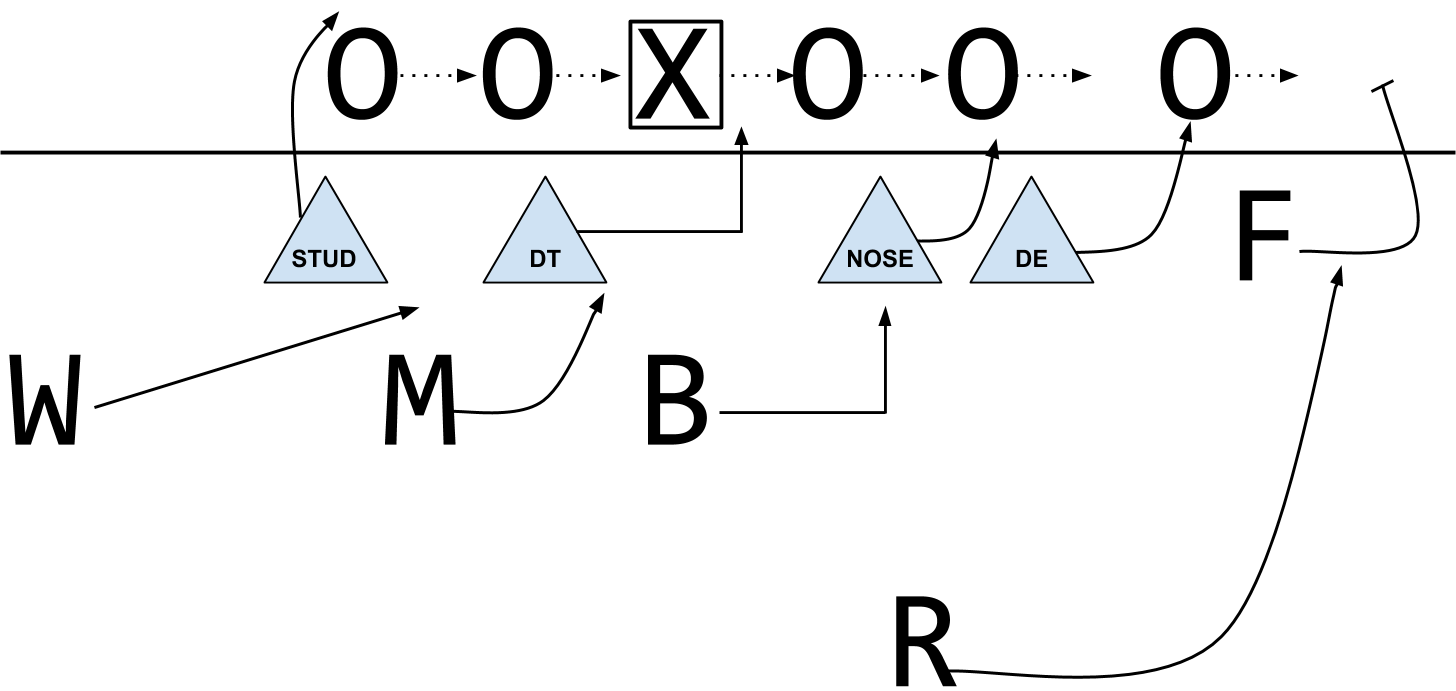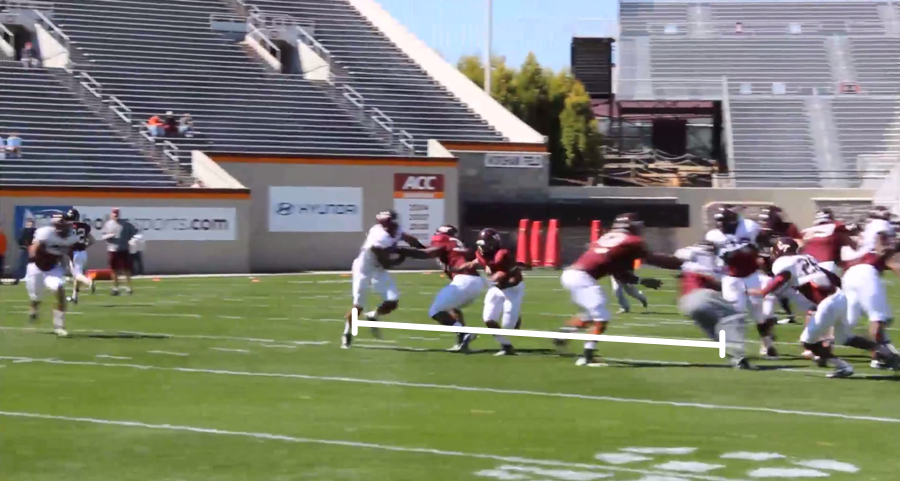Today, I'm going to break down two basic principles of the Virginia Tech offense and defense matched against each other—the zone stretch versus the gap fit.
In Bud Foster's gap defense, each of the front-six defenders (all four down linemen and the two inside linebackers) have responsibility to attack a gap and either make a play in the gap or occupy it without being driven out. The outside "linebacker-safeties" (Whip and Rover) are edge players. Based on a defensive call they either "force" the play, playing outside contain to force the running back to the inside, or "spill" the play, attacking the inside shoulder of the running back, forcing him to bounce outside to an unblocked alley player which is often the free safety. Against teams that zone block running plays, the normal "key" for an interior player is go where the offensive lineman goes, cross his face, and fit the gap to his outside.

Let's start with alignment rules.
- Stud end is aligned over the RIGHT offensive tackle.
- Defensive Tackle is aligned over the RIGHT offensive guard.
- Nose Tackle is aligned over the LEFT offensive guard.
- Defensive end is aligned over the LEFT offensive tackle.
- Backer is to the boundary.
- Mike is to the field.
- Rules for Whip vary based on opponent. When the Hokies are in an eight-man front, the Whip aligns away from the strength of the passing formation (with the Rover to the strength). When the Hokies are in a 4-2-5 with the Rover playing as a traditional strong safety, generallly the Rover will play to the boundary and the Whip will play to the field.
- On most defensive snaps when the Rover aligns away from the line of scrimmage, the Rover will be to the boundary and the free safety will be to the field. An exception (as you will see below) is against a pro-set offense with two good receivers. If the Hokies are in man coverage, and the offense motions the boundary receiver to the slot on the field side, the boundary corner will motion with him and the Rover and free will both play on the boundary side where the only passing threats are the tight end and a running back. The Hokies had great success using this variant against Pitt.
Each of the interior front-six has a gap fit responsibility. The offensive line zone blocks to their left, so each front-six defender will mirror the blocker, cross his face, and fit into the gap one over from their original alignment. This amounts to a gigantic slant to the right of the defense. On the back side, the Stud end trailing the play either has contain responsibility (getting slightly up field to attack a bootleg or reverse), or a crash call where he pursues hard to the inside and hammers the running back if he cuts back.
In this alignment, the free safety plays a "force" technique. He widens way outside of the tight end's reach block, keeps his outside shoulder free, and forces the running back to the inside where there should be a wall of defenders slanting. The Rover is deep and is an alley player. Pre-snap, he makes a call to the free safety at the line. If the free safety plays a force technique, the Rover will come up INSIDE of the free safety in case the back finds a seam on the cutback. If the free safety plays a spill technique, the running back will bounce wide so the Rover takes an outside angle to the running back. Either way, it is doubtful that the Rover will be blocked.
Behind the play, the Whip is the free hitter if the Stud has bootleg responsibility. The Whip comes from wide. He can be aggressive because he doesn't have coverage responsibility. He flies at a flat angle and should be sitting in the cutback lane (which will form between the Mike linebacker and the Stud end). If the Whip gets where he needs to be, he makes the tackle for a short gain.
This is defense run like offense. Every defender has a predetermined place they have to go based on their keys. They are not asked to read the play, defeat a blocker, and find the football. The system has defenders moving at the snap. The movement looks chaotic and will confuse the offense, leading to big impact plays. Even if the offense blocks correctly, if every player completes their assignment every gap will be accounted for and there will be nowhere to run. This system coupled with players who learn it, trust it, and can execute it, makes average athletes look terrific, and elite ones unstoppable.
But, it is high risk. If too much space forms between two gap fits, or if the free hitters in the alley or the back side miss a tackle, it also gives up big plays in the running game.
During the practice periods prior to the first spring scrimmage, the first team offense did a short series of plays against the first team defense. I am not sure if the defense was giving a look or going full speed (Chase Williams was wearing sweats over his pants) but the offense managed some big plays by using the zone stretch to create bubbles in the gap scheme. Thanks to Andy Bitter of The Roanoke Times, there's a video clip of one of those plays.
00:00:20–00:00:29
On this play, Coach Loeffler's offense runs an inside zone to the left (to the boundary). The formation has a tight end (Bucky Hodges) lined up outside of left tackle Jonathan McLaughlin (on the right of your screen) with Darius Redman lined up as an H-Back/fullback behind right guard Augie Conte. At the snap, each blocker zone/reach blocks to their left. The defensive front responds as I diagrammed above. Detrick Bonner forces the cutback, with Ken Ekanem, Corey Marshall, and Deon Clarke fitting at the aiming point of tailback J.C. Coleman.
Coleman uses textbook technique. He takes the stretch handoff, pressures the line, and then plants his outside foot. He sees a seam forming behind the block of guard Augie Conte, pushes off his outside foot, and assertively hits the seam. At this key moment, the defense breaks down.
Chase Williams fits, but gets collapsed by the back side scoop block of Laurence Gibson, who drives him too far to Williams right. Dadi Nicolas (at Stud end) has to go up field to take away the threat of a bootleg, and gets scooped on a clever block by the fullback Redman. As result, there is a big seam for Coleman to run through.

The Rover has to play the alley inside of the free safety force, so he is effectively out of the play. The Whip should fly into the screen and make the late tackle on Coleman, but it appears that the motion from Willie Byrn caused some confusion between Whip Josh Trimble and Kendall Fuller mirroring Byrn. Trimble is late, and Coleman is off to the races.
This is bread and butter football for both the Virginia Tech offense and defense. Running the football and stopping the run are two fundamental principles for the Hokies and any success this fall starts first with succeeding on these basic fundamental techniques. Here, the offense wins, which is a good sign given the struggles to run the football last season.


Comments
Please join The Key Players Club to read or post comments.
Please join The Key Players Club to read or post comments.
Please join The Key Players Club to read or post comments.
Please join The Key Players Club to read or post comments.
Please join The Key Players Club to read or post comments.
Please join The Key Players Club to read or post comments.
Please join The Key Players Club to read or post comments.
Please join The Key Players Club to read or post comments.
Please join The Key Players Club to read or post comments.
Please join The Key Players Club to read or post comments.
Please join The Key Players Club to read or post comments.
Please join The Key Players Club to read or post comments.
Please join The Key Players Club to read or post comments.